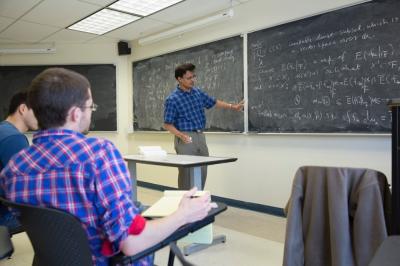Barbara Keyfitz and Sanjeevi Krishnan

The pandemic has affected graduate student life in myriad ways. On behalf of the Graduate Studies Committee, we conducted an online, free-response questionnaire addressed to the graduate students in the department. About one-fifth of the department's graduate students took advantage of the opportunity to give their anonymous opinions about the changes forced on their program by the pandemic.
On taking classes and seminars: Generally, online videos and lecture notes were found to be adequate in conveying basic material. In fact, the convenience of asynchronous, repeatable and one-way video lectures (e.g., surreptitiously checking definitions during talks, snacking!) was welcomed. Some respondents missed the convenience of large chalkboards, particularly well-suited for the kinds of diagrammatic arguments typical in math. At least one student felt that hybrid classes combined the worst of both modes.
But what was most sorely missed was interaction. Gone were liminal spaces for informal clarification: right before or after class with a professor, teatime with classmates and speakers, lunch and dinner with visitors. Even the inability for students to gauge the real-time, non-verbal reactions of other students left at least one graduate student unnerved. The situation was particularly difficult for first-year students, who have not had any of the usual beginning-graduate-school experiences of getting to know a group of people with similar goals and interests and becoming immersed in their new community. Several faculty members encouraged students to work in groups, and this helped. Students also formed student-led seminar and discussion groups and some facsimile of social interactions.
On teaching: Graduate teaching assistants, especially those teaching for the first time, had a difficult semester. Instant feedback, normal for in-person teaching, was missed. Students often chose to turn off videos (no doubt snacking!) during lectures; it was suggested that instructors strongly encourage their students to broadcast their faces. Attendance was worse than normal, maybe due in part to the availability of recorded lectures. The format of Zoom sessions seemed to discourage students in some classes from freely asking questions when needed.
An oft-repeated claim was the prevalence of cheating. There were serious complaints about the technology that Ohio State supplied: Gradescope, the suggested online grading system, does not interoperate with Carmen; there were difficulties in administering timed exams; students felt that Ohio State was not getting good value for their investments in these instruments.
A common concern was the increased workload for graders. The shift to online learning has encouraged a shift towards problem-centric curricula, organized around more frequent problem sets, projects and quizzes.

Figure. Academic interaction, then and now.
On research: While the advisor-advisee relationship has largely survived the stay-at-home restrictions, progress on actual research was mixed. Some students felt that they had progressed during the semester, but most were frustrated. Research is reportedly stalled for many graduate students who thrive on spontaneous collaboration and interaction. Anxiety over pandemic-related uncertainty in summer funding was mentioned several times.
On academic life: The survey did not specifically ask students about how they managed their lives; since everyone (student or not) is experiencing about the same thing, one can imagine. Specific concerns included "staring down the job market" and uncertainty about continued funding, as the university's budget problems have been much publicized. None of the students who answered the survey commented on one concern for faculty who want to promote professional development. That is the problem that students, while learning a lot about remote learning and teaching, missed a semester of the normal type of teaching and mentoring that is part of the education they receive here.
